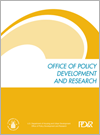
Although it once was seldom enforced, a series of legislative amendments and administrative changes in the early 1990s strengthened Section 3 considerably. For example, 1994 regulations created goals for employment of public housing residents, which PHAs could meet through resident outreach activities, job training and counseling, hiring residents inhouse, working with contractors to hire residents, and contracting with resident-owned firms. However, the report finds that even the most aggressive PHAs face several challenges to meeting those goals, including:
Contracting/Procurement. HUD and often State or local laws mandate that PHAs accept the lowest responsible bid for contracts. Such mandates are unclear about the weight that may be given to the quality of competing firms' Section 3 plans.
Scale, Duration, and Types of Jobs Available. Relative to the need for jobs in public housing, strong Section 3 strategies appear to generate only a small number of employment opportunities. This is due in part to the types of jobs typically available through Section 3: construction jobs that are short-term and highly seasonal. These jobs may be only as general laborers, in which residents learn few marketable skills.
Residents' Preparation for Work. At the studied sites, PHA administrators, contractors, and residents noted that residents were frequently deficient in work-readiness skills such as attendance, accepting supervision, getting along with coworkers, and problem solving -- underscoring the need for pre-employment training. PHA residents are also often hampered by low self-esteem and a lack of support for dealing with personal problems such as child care and transportation. Despite these barriers, four of the seven sites studied appeared to be implementing strong individual program components.



